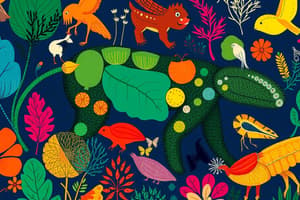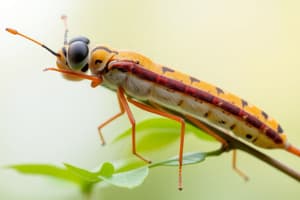Podcast
Questions and Answers
What is the process of grouping together related organisms known as?
What is the process of grouping together related organisms known as?
- Classification (correct)
- Diversification
- Organization
- Categorization
Who was one of the first to classify animals based on their habitat and physical features?
Who was one of the first to classify animals based on their habitat and physical features?
- Mendel
- Aristotle (correct)
- Carl Linnaeus
- Darwin
Which scientist developed modern biological taxonomy using DNA analysis in the 18th century?
Which scientist developed modern biological taxonomy using DNA analysis in the 18th century?
- Aristotle
- Darwin
- Mendel
- Carl Linnaeus (correct)
What term refers to the variety of ecosystems found on Earth?
What term refers to the variety of ecosystems found on Earth?
Which of the following is NOT one of the six recognized kingdoms of life?
Which of the following is NOT one of the six recognized kingdoms of life?
Why is the conservation of biodiversity an important focus?
Why is the conservation of biodiversity an important focus?
What is one of the major threats to global food security, economic development, and environmental health?
What is one of the major threats to global food security, economic development, and environmental health?
What is habitat degradation primarily caused by?
What is habitat degradation primarily caused by?
How does protecting biodiversity ensure habitats remain safe for life?
How does protecting biodiversity ensure habitats remain safe for life?
What is the term used to collectively refer to the vast array of forms and functions of various organisms?
What is the term used to collectively refer to the vast array of forms and functions of various organisms?
Why do classifications of organisms help scientists?
Why do classifications of organisms help scientists?
Which human activity is NOT mentioned as a cause of habitat degradation in the text?
Which human activity is NOT mentioned as a cause of habitat degradation in the text?
Study Notes
The Living World
Life on Earth is diverse and fascinating, and understanding it requires categorizing living things into groups based on their shared characteristics. This process of grouping together related organisms is known as classification. It's essential because it helps us understand how different species relate to each other, predict the behavior of certain organisms, and even control the spread of diseases.
Classification systems have been around since ancient times, with Aristotle being one of the first to classify animals by their habitat and physical features. However, modern biological taxonomy, which uses DNA analysis to determine relationships between species, was developed by Carl Linnaeus in the 18th century. Today, we recognize six kingdoms of life: Eubacteria, Archaebacteria, Fungi, Plantae, Animalia, and Protista. Within these kingdoms, there are classes, orders, families, genera, and species, all carefully arranged to reflect evolutionary relationships among them.
One fundamental aspect of the living world is its immense variety of different forms of life called Biodiversity. Biodiversity refers to the range of ecosystems found across our planet and the number of distinct types of plants, animals, microorganisms, and ecosystems they comprise. There has been significant focus on conserving this diversity due to two factors - human population growth and climate change. These issues threaten global food security, economic development, and environmental health.
A crucial component of protecting biodiversity is preserving habitats where various species live. Habitat degradation occurs when natural environments like forests, grasslands, wetlands, deserts, or oceans are altered or destroyed by human activities such as agriculture, urbanization, pollution, deforestation, overhunting, fishing, mining, damming rivers, and introducing invasive species. As more land is lost to agriculture and development, wildlife populations decline rapidly and entire ecosystems disappear. Protecting biodiversity means ensuring these unique places remain safe havens for life.
In conclusion, studying the living world involves understanding how organisms are classified and exploring their vast array of forms and functions collectively referred to as biodiversity. Classifications help scientists better comprehend relationships among species while also providing tools to conserve this precious resource—our living Earth.
Studying That Suits You
Use AI to generate personalized quizzes and flashcards to suit your learning preferences.
Description
Explore the classification system in biology and the significance of biodiversity in the living world. Learn about the importance of grouping organisms based on shared characteristics and the threats to biodiversity from human activities like habitat degradation.




